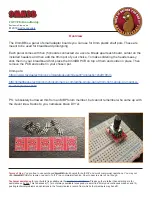
DMU380ZA Series
User’s Manual
________________________________________________________________________
Doc# 7430-3810 Rev. 02
Page 12
The axes form an orthogonal SAE right-handed coordinate system. Acceleration is
positive when it is oriented towards the positive side of the coordinate axis. For example,
with a DMU380ZA Series product sitting on a level table, it will measure zero g along
the x- and y-axes and -1 g along the z-axis. Normal Force acceleration is directed
upward, and thus will be defined as negative for the DMU380ZA Series z-axis.
The angular rate sensors are aligned with these same axes. The rate sensors measure
angular rotation rate around a given axis. The rate measurements are labeled by the
appropriate axis. The direction of a positive rotation is defined by the right-hand rule.
With the thumb of your right hand pointing along the axis in a positive direction, your
fingers curl around in the positive rotation direction. For example, if the DMU380ZA
Series product is sitting on a level surface and you rotate it clockwise on that surface, this
will be a positive rotation around the z-axis. The x- and y-axis rate sensors would
measure zero angular rates, and the z-axis sensor would measure a positive angular rate.
The magnetic sensors are aligned with the same axes definitions and sign as the linear
accelerometers. For example, when oriented towards magnetic North, you will read
approxi0.25 Gauss along X, 0.0 Gauss along Y, and +0.35 Gauss along Z
direction (North America). Magnetic values at other geographic locations can be found at
http://www.ngdc.noaa.gov/seg/WMM/DoDWMM.shtml
Pitch is defined positive for a positive rotation around the y-axis (pitch up). Roll is
defined as positive for a positive rotation around the x-axis (roll right). Yaw is defined as
positive for a positive rotation around the z-axis (turn right).
The angles are defined as standard Euler angles using a 3-2-1 system. To rotate from the
body frame to an earth-level frame, roll first, then pitch, and then yaw.
The position output from GPS is represented in Latitude, Longitude, and Altitude (LLA)
convention on the WGS84 Ellipsoid. This is the most commonly used spherical
coordinate system. The GPS velocity is defined in North, East and Down reference
frame. The users can convert this into Cartesian coordinate system, called Earth-
Centered, Earth-Fixed (ECEF). ECEF uses three-dimensional XYZ coordinates (in
meters) to describe the location of a GPS user or satellite. Several online resources are
available to help users with this transformation. For example, refer to the application note
on MEMSIC website,
http://www.memsic.com/support/documentation/inertial-
systems/category/3-application-notes.html
3.1.1
Advanced Settings
The DMU380ZA Series Inertial Systems have a number of advanced settings that can be
changed. The specific settings available vary from unit to unit, and a detailed description
of each unit (IMU, VG, AHRS, and INS) is found in the subsequent sections of this
manual. All units support baud rate, power-up output packet type, output rate, sensor low
pass filtering, and custom axes configuration. The units can be configured using NAV-
VIEW, as described in Appendix A, and also directly with serial commands as described
in Sections 6-9.
IMU380ZA Theory of Operation
3.2
The product name, IMU380ZA, stands for Inertial Measurement Unit 380, and the name
is indicative of the inertial measurement unit functionality that the IMU380ZA provides
by providing inertial rate and acceleration data in 6-DOF (six degrees of freedom). The
IMU380ZA signal processing chain consists of the 6-DOF sensor cluster, programmable
low-pass filters, and the signal processor for sensor error compensation. The IMU380ZA,
as with other DMU380ZA Series variants, has a UART input/output port and a SPI
input/output port.
















































